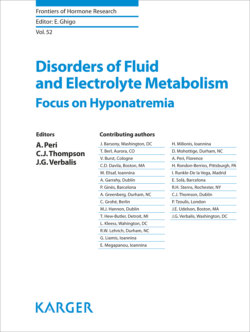Читать книгу Disorders of Fluid and Electrolyte Metabolism - Группа авторов - Страница 26
На сайте Литреса книга снята с продажи.
Renal Handling of Water
ОглавлениеProximal Tubule
The glomerulus filters 125 mL of plasma every minute, that is, glomerular filtration rate (GFR). The proximal tubule (PT) reabsorbs 65–80% of the filtered water. The reabsorption of sodium along with other solutes from the tubular fluid into the lateral intercellular spaces reduces the osmolality of the tubular fluid and increases the osmolality of the lateral intercellular space, providing an osmotic gradient for transcellular water reabsorption. The PT is highly permeable to water in keeping with the high expression of aquaporin 1 water channels (AQP1) in the apical and basolateral membrane. The accumulation of fluid and solutes in the renal interstitium increases the hydrostatic pressure in this compartment, providing along with changes in peritubular protein concentration, and the Starling forces that govern the movement of fluid into theses capillaries as reflected in this formula:
where Kf is the filtration coefficient, Pc is the peritubular capillary hydrostatic pressure, Pi is the renal interstitium hydrostatic pressure, Πc is the peritubular capillary oncotic pressure, and Πi is the renal interstitium oncotic pressure.
Renal hemodynamics influence rates of water reabsorption in PT. Pc is determined by arterial blood pressure and vascular resistance in afferent and efferent arterioles. Increases in Pc decrease water reabsorption, while decrements in Pc increases water reabsorption in PT. The oncotic pressure Πc is determined by serum albumin concentration and filtration fraction (GFR/RPF; RPF = renal plasma flow). Increases in serum albumin concentration raise Πc and hence increase water reabsorption. An increase in filtration fraction increases the concentration of albumin in peritubular capillaries as a greater percentage of the blood entering the glomerulus crosses the filtration barrier with albumin free fluid, thereby enriching its concentration in the blood emerging into the peritubular capillaries. This will lead to an increased water reabsorption in PT. Conversely, when the filtration fraction decreases, capillary albumin is lower and so is water reabsorption.
